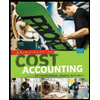
Evaluating the LIFO and FIFO Choice When Costs Are Rising and Falling (AP7-3)
Income is to be evaluated under four different situations as follows:
a. Prices are rising:
- (1) Situation A: FIFO is used.
- (2) Situation B: LIFO is used.
b. Prices are falling:
- (1) Situation C: FIFO is used.
- (2) Situation D: LIFO is used.
The basic data common to all four situations are: sales, 500 units for $15,000; beginning inventory, 300 units; purchases, 400 units: ending inventory, 200 units: and operating expenses, $4,000. The following tabulated income statements for each situation have been set up for analytical purposes:
| PRICES RISING | PRICES FALLING | |||
| Situation A FIFO | Situation B LIFO | Situation C FIFO | Situation D LIFO | |
| Sales revenue | $15,000 | $15,000 | $15,000 | $15,000 |
| Cost of goods sold: | ||||
| Beginning inventory | 3,300 | ? | ? | ? |
| Purchases | 4,800 | ? | ? | ? |
| Goods available for sale | 8,100 | ? | ? | ? |
| Ending inventory | 2,400 | ? | ? | ? |
| Cost of goods sold | 5,700 | ? | ? | ? |
| Gross profit | 9,300 | ? | ? | ? |
| Expenses | 4,000 | 4,000 | 4,000 | 4,000 |
| Pretax income | 5,300 | ? | ? | ? |
| Income tax expense (30%) | 1,590 | ? | ? | ? |
| Net income | $ 3,710 | |||
Required:
- 1. Complete the preceding tabulation for each situation. In Situations A and B (prices rising), assume the following: beginning inventory, 300 units at $11 = $3,300: purchases, 400 units at $12 = $4,800. In Situations C and D (prices falling), assume the opposite; that is. beginning inventory, 300 units at $12 = $3,600; purchases. 400 units at $11 = $4,400. Use periodic inventory procedures.
- 2. Analyze the relative effects on pretax income and net income as demonstrated by requirement (1) when prices are rising and when prices are falling.
- 3. Analyze the relative effects on the cash position for each situation.
- 4. Would you recommend FIFO or LIFO? Explain.
1.
Complete the preceding tabulation for each situation.
Answer to Problem 7.5P
| Prices Rising | Prices Falling | |||
| Particulars | A | B | C | D |
| FIFO | LIFO | FIFO | LIFO | |
| Sales revenue (a) (1) | $15,000 | $15,000 | $15,000 | $15,000 |
| Beginning inventory | 3,300 | 3,300 | 3,600 | 3,600 |
| Add: Purchases | 4,800 | 4,800 | 4,400 | 4,400 |
| Goods available for sale Table (2) | 8,100 | 8,100 | 8,000 | 8,000 |
| Less: Ending inventory | 2,400 Table (3) | 2,200 Table (4) | 2,200 Table (5) | 2,400 Table (6) |
| Cost of goods sold (b) Table (7) | 5,700 | 5,900 | 5,800 | 5,600 |
| Gross profit | 9,300 | 9,100 | 9,200 | 9,400 |
| Less: Expenses | 4,000 | 4,000 | 4,000 | 4,000 |
| Pretax income | 5,300 | 5,100 | 5,200 | 5,400 |
| Less: Income tax expense | 1,590 | 1,530 (2) | 1,560 (3) | 1,620 (4) |
| Net income | $3,710 | $3,570 | $3,640 | $3,780 |
Table (1)
Explanation of Solution
Periodic Inventory System:
Periodic inventory system is a system, in which the inventory is updated in the accounting records on a periodic basis such as at the end of each month, quarter or year. In other words, it is an accounting method which is used to determine the amount of inventory at the end of each accounting period.
First-in-First-Out:
In First-in-First-Out method, the costs of the initially purchased items are considered as cost of goods sold, for the items which are sold first. The value of the ending inventory consists of the recent purchased items.
Last-in-Last-Out:
In Last-in-First-Out method, the costs of last purchased items are considered as the cost of goods sold, for the items which are sold first. The value of the closing stock consists of the initial purchased items.
Cost of goods sold:
Cost of goods sold is the accumulate total of all direct cost incurred in manufacturing the goods or the products which has been sold during a period. Cost of goods sold involves direct material, direct labor, and manufacturing overheads.
Working notes:
Determine the amount of sales revenue:
Determine the goods available for sale for FIFO:
| Date | Particulars | Units ($) | Unit cost ($) | Total cost ($) |
| (a) | (b) | (c = a × b) | ||
| January 1 | Beginning inventory | 300 | 11 | 3,300 |
| January 12 | Purchased | 400 | 12 | 4,800 |
| Total | 700 | 8,100 | ||
| Less: Goods sold | 500 | |||
| Ending inventory | 200 |
Table (2)
Determine the amount of ending inventory for situation A using FIFO method:
| Date | Particulars | Units | Unit cost ($) | Total cost ($) |
| (a) | (b) | (c = a × b) | ||
| Purchased | 200 | 12 | 2,400 | |
| Ending inventory | 200 | 2,400 |
Table (3)
Determine the amount of ending inventory for situation B using LIFO method:
| Date | Particulars | Units | Unit cost ($) | Total cost ($) |
| (a) | (b) | (c = a × b) | ||
| Purchased | 200 | 11 | 2,200 | |
| Ending inventory | 200 | 2,200 |
Table (4)
Determine the amount of ending inventory for situation C using FIFO method:
| Date | Particulars | Units | Unit cost ($) | Total cost ($) |
| (a) | (b) | (c = a × b) | ||
| Purchased | 200 | 11 | 2,200 | |
| Ending inventory | 200 | 2,200 |
Table (5)
Determine the amount of ending inventory for situation D using LIFO method:
| Date | Particulars | Units | Unit cost ($) | Total cost ($) |
| (a) | (b) | (c = a × b) | ||
| Purchased | 200 | 12 | 2,400 | |
| Ending inventory | 200 | 2,400 |
Table (6)
Determine the amount of cost of goods sold for each method:
| Situation | Particulars | Units | Unit cost ($) | Total cost ($) |
| (a) | (b) | (c = a × b) | ||
| a. FIFO | Beginning | 300 | 11 | 3,300 |
| Purchased | 200 | 12 | 2,400 | |
| 500 | 5,700 | |||
| b. LIFO | Beginning | 100 | 11 | 1,100 |
| Purchased | 400 | 12 | 4,800 | |
| 500 | 5,900 | |||
| c. FIFO | Beginning | 300 | 12 | 3,600 |
| Purchased | 200 | 11 | 2,200 | |
| 500 | 5,800 | |||
| d. LIFO | Beginning | 100 | 12 | 1,200 |
| Purchased | 400 | 11 | 4,400 | |
| 500 | 5,600 |
Table (7)
Determine the amount of income tax expense for Situation B:
Determine the amount of income tax expense for Situation C:
Determine the amount of income tax expense for Situation D:
2.
Analyze the relative effects on pretax income and net income, when there is a rise and fall in prices.
Answer to Problem 7.5P
The amounts of pretax income when there is rise and fall in prices are compared as below:
| Particulars |
Situation A FIFO ($) |
Situation B LIFO ($) |
Difference ($) |
| Pretax income when prices are rising | 5,300 | 5,100 | 200 |
|
Situation C FIFO ($) |
Situation D LIFO ($) |
Difference ($) | |
| Pretax income when prices are falling | 5,200 | 5,400 | 200 |
Table (8)
Explanation of Solution
- From the above calculation, it is clear that the difference between the pretax tax income between FIFO and LIFO is same. Thus, a difference in inventory has a dollar-for-dollar effect on pretax income.
- When price rises, the FIFO method gives a higher net income than the LIFO method. On the other hand, when there is a fall in price, the LIFO method gives a higher net income than the FIFO method.
3.
Analyze the relative effects on the cash position for each situation.
Explanation of Solution
- The LIFO method gives most favorable cash position than the FIFO method, when prices are rising. On the other hand, the FIFO method gives most favorable cash position than the LIFO method, when prices are falling. Thus, these cash positions are equal to the difference in income tax.
4.
Explain the method that is recommended.
Explanation of Solution
- Both the LIFO method and FIFO method are equally reasonable in their aspects. For example, when there is a rise in price, the FIFO method produces most favorable results than LIFO by focusing on current income and EPS.
- On the other hand, when there is a rise in price, the LIFO method also produces most favorable results than FIFO by focusing on income tax expenses and cash position. Still, these results will reverse when there is a fall in prices.
- On the income statement, FIFO does not match current expense with current revenues. However it provides a better valuation on the balance sheet. On the other hand, LIFO matches expenses with revenues. However, it provides a less related inventory valuation on the balance sheet.
Want to see more full solutions like this?
Chapter 7 Solutions
Financial Accounting
- Can you help me solve this general accounting question using the correct accounting procedures?arrow_forwardQuestion 1181 28 Current Attempt in Progress Here are comparative balance sheets for Migitsu Company. Prepare a statement of cash flows-indirect method. MIGITSU COMPANY Comparative Balance Sheets December 31 Assets 2020 2019 Cash $73,000 $22,000 Accounts receivable 87,000 76.000 Inventory 170,000 191.000 Land 72,000 100.000 Equipment 260,000 200.000 Accumulated depreciation - equipment (66,000) (32.000) Total $596,000 $557,000 Liabilities and Stockholders' Equity Accounts payable $37,000 $47.000 Bonds payable 150,000 210,000 Common stock ($1 par) 216.000 174,000 Retained earnings 193,000 126.000 Total $596,000 $557,000 Additional information: 1 Net income for 2020 was $100,000. N Cash dividends of $33,000 were declared and paid. 3. Bonds payable amounting to $60,000 were redeemed for cash $60,000. -18 4. Common stock was issued for $42,000 cash. 5. Equipment that cost $50,000 and had a book value of $30,000 was sold for $36,000 during 2020; land was sold at cost.arrow_forwardI need guidance with this general accounting problem using the right accounting principles.arrow_forward
 Intermediate Accounting: Reporting And AnalysisAccountingISBN:9781337788281Author:James M. Wahlen, Jefferson P. Jones, Donald PagachPublisher:Cengage LearningPrinciples of Accounting Volume 2AccountingISBN:9781947172609Author:OpenStaxPublisher:OpenStax College
Intermediate Accounting: Reporting And AnalysisAccountingISBN:9781337788281Author:James M. Wahlen, Jefferson P. Jones, Donald PagachPublisher:Cengage LearningPrinciples of Accounting Volume 2AccountingISBN:9781947172609Author:OpenStaxPublisher:OpenStax College Principles of Cost AccountingAccountingISBN:9781305087408Author:Edward J. Vanderbeck, Maria R. MitchellPublisher:Cengage Learning
Principles of Cost AccountingAccountingISBN:9781305087408Author:Edward J. Vanderbeck, Maria R. MitchellPublisher:Cengage Learning


